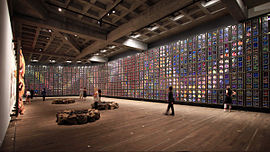| Snake | |
|---|---|
 | |
| Artist | Sidney Nolan |
| Year | 1970–72 |
| Medium | Ink, dye, and wax crayon on card |
| Dimensions | 9.14 m × 45.72 m (30.0 ft × 150.0 ft) |
| Location | Museum of Old and New Art, Hobart, Tasmania, Australia |
Snake is an artwork by Australian artist Sir Sidney Nolan. Created between 1970 and 1972, it consists of 1,620 panels arranged so that the images on each panel form a larger image of a snake. It is part of the collection of the Museum of Old and New Art (MONA) in Hobart, Australia.
Nolan is believed to have created the work after "he saw a mural in a Beijing palace that moved him to create an Australian version, inspired by the desert in springtime"
Nolan developed a gestural language for Snake in the same way that most artists work. He composed and executed a little picture, influenced, as we all know, by aboriginals and their art, and New Guineans, and their snake dances. He then painted similar scenes with a quicker hand and fewer gestures, and he repeated this thousands of times, till the paintings were made by muscle memory.
— David Walsh,
David Walsh, MONA's owner, purchased the work in 2005 for AUD$2m. Walsh modified his initial design for MONA to make space for the work. Before its installation there, Snake was shown in England and Ireland.
References
- ^ Walsh, David. "No. 18 Snake". #Nolan 100. Sidney Nolan Trust. Retrieved 18 August 2019.
- ^ Claridge, Alice (4 September 2014). "MONA's Sidney Nolan masterpiece Snake back on display". The Mercury. Retrieved 19 August 2019.
- ^ Coslovich, Gabrielle (15 January 2011). "A revolt in art". Sydney Morning Herald. Retrieved 18 August 2019.
| Sidney Nolan | |
|---|---|
| Paintings |
|
| Related | |
This article about Australian culture is a stub. You can help Misplaced Pages by expanding it. |
This article about a twentieth-century painting is a stub. You can help Misplaced Pages by expanding it. |